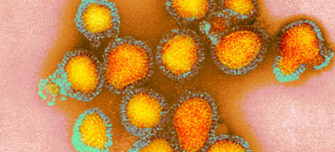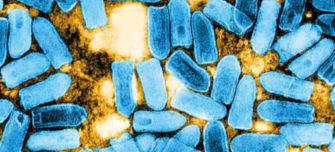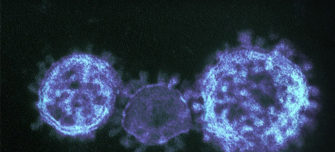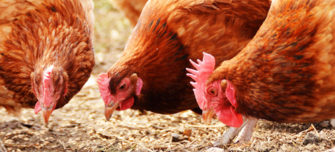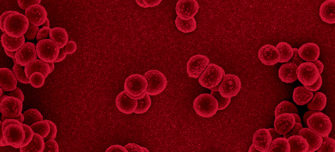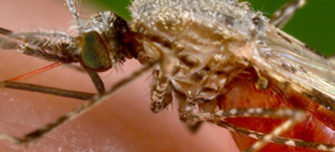Resources and further reading
-
Viruses
Viruses are the smallest of all the microbes. They are said to be so small that 500 million rhinoviruses (which cause the common cold) could fit on to the head of a pin. They are unique because they are only alive and able to multiply inside the cells of other living things. The cell they multiply in is called the host cell.
-
Microbiology Today: Arboviruses and their Vectors
This issue of Microbiology Today considers some of the viruses that are transmitted by arthropods and the arthropod vectors that carry them.
-
Microbiology Today: Pathogens
Learn more about the opportunistic pathogens in hospitals and the air-borne spread of foot-and-mouth disease
-
Metals in Microbiology: journal collection
Guest-edited by Dr Jennifer Cavet (University of Manchester) and Dr Karrera Djoko (Durham University), this collection of keynote research articles will highlight research on metal-microbe interactions, bringing together advances in our understanding of how microbes handle metals, the utilization of metals in proteins and the importance of metal handling systems in host-pathogen interactions.
-
Arboviruses and their Vectors journal collection
Curated by Journal of General Virology Editor Dr Eng Eong Ooi (Duke NUS Medical School) and Advisory Board Member Dr Esther Schnettler (Bernhard Nocht Institute for Tropical Medicine), this collection presents the latest advances in arbovirus research.
-
Coronaviruses journal collection
Coronaviruses are a large family of viruses that can infect a range of hosts. They are known to cause diseases including the common cold, severe acute respiratory syndrome (SARS) and Middle East respiratory syndrome (MERS) in humans.
-
Outbreak Reports journal collection
This collection highlights Outbreak Reports published in Microbial Genomics. Outbreak reports are short-format articles that investigate the key role that genomics plays in investigating communicable disease outbreaks.
-
Mycobacterium tuberculosis journal collection
World Tuberculosis Day, on 24 March, recognises the date in 1882 when Dr Robert Koch announced his discovery of Mycobacterium tuberculosis, the bacillus that causes tuberculosis (TB). Here we present a collection of published papers on M. tuberculosis.
-
Avian Viruses journal collection
This collection presents high-quality work on important avian pathogens and their host interactions. The collection is curated by Journal of General Virology Editor Professor Paul Britton and Editorial Board Member Dr Mike Skinner.
-
Ebola Virus Disease journal collection
This collection brings together articles from our portfolio of journals on Ebola virus disease. The Microbiology Society has made this content freely available in the interests of widest possible distribution of relevant research.
-
One year of SARS-CoV-2 evolution
Researchers published an in-depth look at the SARS-CoV-2 mutations that have taken place during the past year in the Journal of General Virology.
-
Submit the next Journal of General Virology profile image
This year Journal of General Virology invites members of the microbiology community to participate in the Microbiology Images project and submit the next Journal of General Virology profile image. Find out more details on how to submit your images today.
-
Discovery of a new virus that could spread from crabs to sharks
Researchers have been investigating how viruses spread between marine animals. Rhys Parry, a PhD candidate in the Asgari Lab at the University of Queensland, has identified a number of viruses which spread between marine animals, including an unexpected discovery of a virus that spreads from crabs to sharks.
-
Mosquitoes in the Netherlands capable of transmitting Zika and Usutu viruses
Researchers have found that a species of mosquito in the Netherlands is capable of transmitting viruses Zika and Usutu in the laboratory. The mosquito, called the Asian bush mosquito (Aedes japonicus) was first discovered in the Netherlands in 2013. This mosquito is usually seen in Japan and Korea but has become an invasive species in Europe and the US.
-
In pictures: The first images of a coronavirus
Today, the word ‘coronavirus’ has become a part of everyone’s daily vocabulary. It’s difficult to believe that 60 years ago the very existence of these viruses was disputed by experts, with the first images of coronavirus written off as badly imaged influenza. Now, as the coronavirus SARS-CoV-2 continues to change the world as we know it, the history of coronaviruses is being revisited.
-
Keeping up with virus taxonomy: viruses that infect other microbes
Continuing the ‘Keeping up with virus taxonomy’ blog series, in this post we look at the viruses that infect fungi, bacteria and archaea.
-
How is the hepatitis C-like hepacivirus of horses transmitted?
Previously, HCV and its relatives were believed to be limited to humans and chimpanzees, so the discovery of a virus that infected another species was exciting for researchers. It opened up the possibility that canine hepacivirus could be used as a model to understand how HCV infects humans, as we explore in this blog.
-
A history of Pseudomonas aeruginosa PA14
Pseudomonas aeruginosa UCBPP-PA14 is a unique strain. It can cause severe disease in both plants and animals. Because of this, it is becoming increasingly popular in pathogenesis research. In this blog, we find out why.
-
Visualising bluetongue virus in midges
Alice Muntzer is a researcher at The Pirbright Institute, working on localising bluetongue virus inside Culicoides midges. Her group has developed a method for visualising and quantifying the virus, and she discusses more about her research in this blog.
-
Mosquito bites: More than just an irritation?
In this blog, Dr Clive McKimmie talks about his group’s research on immune responses to mosquito bites and how the bites themselves may be involved in viral disease.
-
Viruses hijack cellular microRNAs for their own advantage
In this blog, we learn more about how researchers have found that respiratory syncytial virus (RSV) can manipulate levels of regulatory genetic material called microRNAs, in host cells, helping the virus suppress the immune response to aid its survival.
-
Could European mosquitoes transmit Zika virus?
Zika virus appears to be linked to an increase in babies born with microcephaly, as well as a serious neurological disorder called Guillain-Barré syndrome. Could mosquitoes here also transmit the disease?
-
Microbiology Editor’s Choice: Understanding Streptococcus suis pathogenesis
Streptococcus suis is an important pig pathogen that causes severe economic problems in agricultural industry worldwide. Moreover, it is an emerging zoonotic agent that can cause infections in people in close contact with pork-derived products or infected pigs. In this blog, we learn more about why sortases SrtB and SrtF are essential for disease in pigs.
-
Should we curb our appetite for beef?
In this blog, we explore the research of Dr Christopher Buck from the US National Institutes of Health in Bethesda, Maryland, who is leading studies to understand how consuming beef might be harmful to us. His research focuses on polyomaviruses, a group of small, DNA-based viruses that infect a range of animals.
-
Discovering new lemur parasites in Madagascar
Madagascar is home to many species of wildlife that are found nowhere else on the planet, but expanding human populations are encroaching on its biodiversity. In this blog we explore how people and domestic animals are increasingly coming into contact with wildlife – and opportunities this provides for pathogens to move between them.
-
Ebola in West Africa
Ebola virus disease (EVD) kills up to 90% of those infected, making it one of the deadliest diseases known to affect humans. In this blog, we explore more about the outbreak in West Africa and ongoing efforts to control the virus.
-
Microbe Talk: Predicting the next pandemic
To prevent future disease epidemics, we need a better understanding of the nature of spillover events, and the viruses involved in them. In this podcast, we spoke to Professor Jonna Mazet, Director of the One Health Institute at the University of California, Davis, who is trying to identify any pathogens that might pose a threat to human health.
Image credits:
CDC / Science Photo Library
Science Source/Science Photo Library
iStock/Design Cells
"MERS-CoV" by NIAID is licensed under CC BY 2.0, this image has been modified.
iStock/Dr_Microbe
iStock/monticello
NIAID is licensed under CC BY 2.0
Thinkstock
iStock/Delpixart
iStock/bizoo_n
Thinkstock
Jin Hong
Alice Muntzer et al, Pirbright
CDC on Wikipedia under public domain.
iStock/jarun011
iStock/Dr_Microbe
iStock/Wendy Love
Andrey on Flickr under CC BY 2.0
NIAID is licensed under CC BY 2.0
iStock/Gumpanat

